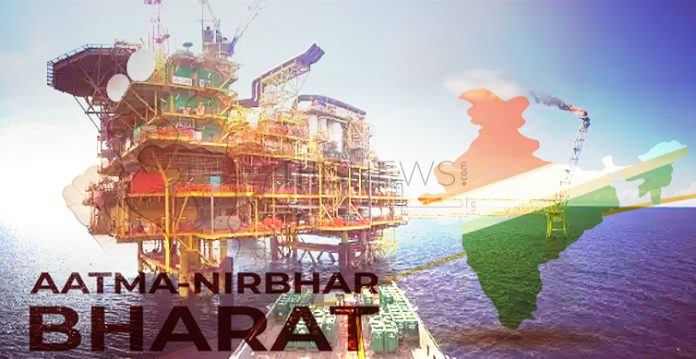New Delhi: India has been making drastic measures to answer Prime Minister Narendra Modi’s clarion call of ‘Aatmanirbhar Bharat’ made during the COVID-19 enforced lockdown. In its walk towards turning into a self-sufficient country that is consciously centered around improving domestic production and lessening imports, it has evaluated innumerable laws and policies to bring in reforms, In such a manner, the oil sector requires special consideration to be able to sufficiently contribute to the PM’s vision.
The biggest obstacle to India becoming Aatmanirbhar Bharat is the country’s reliance on oil imports as India imports more than 80% of its crude oil needs and spent more than $ 100 billion in each of the previous two years doing as such.
This is the situation considering weaker international price trends, otherwise, the forex outgo might have been a lot bigger over the past few years. In value and capacity, India’s oil imports have been on a consistent ascent.
One of the reasons bringing down import reliance has been troublesome is stagnating domestic output. India’s domestic oil production of around 35 million tonnes (MT) isn’t extremely high taking into account the nation’s complete consumption, which is a little more than 200 MT. Be that as it may, if the decrease in domestic production can be arrested, it would lead to the saving of a couple of billion dollars.
The government has taken policy measures to improve domestic oil and gas production and to advance energy efficiency and conservation measures. However, the industry likewise needs to contribute.
There are some low-hanging fruits, fit to be plucked however unfortunately for reasons unknown or other those have not been monetized like the Cairn – Ravva block in coastal Andhra Pradesh and CB-OS/2 block in Cambay, Gujarat. Together these two blocks can possibly produce 24-25 thousand barrels of oil (or similar) every day, equivalent to 1.25 million tonnes per annum.
Essentially, another fit to be tapped is PY-1 Gas Field (offshore of Tamil Nadu), with an expected potential of 12 mmscfd exists, lying untapped because of the absence of investments.
Another resource that is plug and play is PY-3 Gas Field, again offshore Tamil Nadu. Essentially, PY3 has a reserve of 20 million barrels and can contribute around one percent of India’s domestic production yet its advancement is held down because of vested interests. Considering PY-3 can possibly contribute an incremental one percent of domestic production or roughly $ 130-135 million per annum, the likely saving in foreign trade outgo could be worth more than $ one billion or Rs 8,000 crore.
The other asset, CB/OS-2 in the Cambay basin can possibility to produce near 2.5 percent of India’s domestic production. However, interference by MoPNG to ask all parties interested in the block to figure out the issue of sharing cess and royalty from the incremental production in the block.
These and comparative projects exist that in total terms can contribute around 10% of India’s domestic crude oil production. With a laser-sharp focus, issues encompassing these projects should be settled through active engagement of all the stakeholders as the question here is of national interest as opposed to any corporate agenda.
Experts state there should not be any uncertainty by anybody to go the little additional mile to figure out the issues and in this way, help the nation in what small way everybody can.
In a bid to expedite gas and oil exploration and raise domestic production, the government had in 2018 launched the initial bid round under the Open Acreage Licensing Policy (OALP) that permitted explorers to cut out desired areas for exploration and offered liberal terms.
As indicated by the Director-General of Hydrocarbons (DGH), there has been an estimated measure of USD 75 million in investment in four OALP bid rounds till March 31, 2020.
The government has opened India’s Exploration and Production sector by giving more exploration possibilities through Hydrocarbon Exploration and Licensing Policy (HELP) under the Revenue Sharing Contract system.
Through OALP under HELP, more than 1,36,000 sq. km of the acreage has just been granted for exploration to E&P players.
Moreover, Indian sedimentary basins offer Prognosticated Hydrocarbon resources of 30,000 MMtoe in ‘Yet to Be Discovered’ category.
Alongside exceptional changes in the policy framework, many key investor centric measures, for example, environmental clearance for exploratory drilling, preclearance of blocks, digitalising contract management, under the umbrella of ‘Ease of Doing Business’ were likewise introduced. Further, the government is prioritizing to reinforce technological prowess and make governance electronic and automatic.
Government has likewise guided Data-driven reforms in the sector, given the growing dependence on the information in this day and age. (NDR) The National Data Repository, National Core Repository, the Hydrocarbon Resource Reassessment and National Seismic Program (NSP) are a demonstration of the Government’s vision to make quality information accessible, available and implementable to industry, colleges and R&D firms.
Aggregately, these changes are esteemed to positively affect the entries of worldwide Oil and Gas investors in India and translate the possibility offered in this sector into improved hydrocarbon returns.
Time is opportune as the reinvigorated E&P sector in India offers unparalleled opportunities. The new measures will give a streamlined, straightforward, and investor-friendly arrangement to drastically climb up the oil and gas yield for India.


